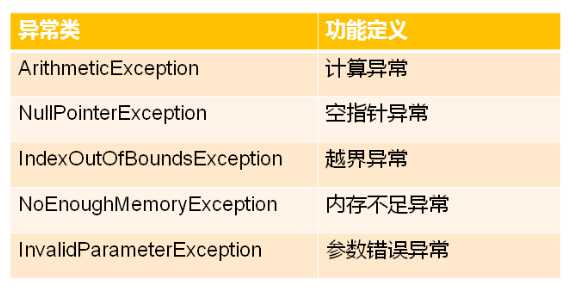标签:code 虚函数 file string 成员变量 his public 父类 cas
1、异常的类型可以是自定义的类类型
2、对于类类型的匹配依旧是之上而下的严格匹配
3、赋值兼容性原则在异常匹配中依然适用
所以要
(1)、匹配子类异常的catch放在上部
(2)、匹配父类异常的catch放在下部
4、异常类是数据结构所依赖的“基础设施”(现代c++库也必然包含充要的异常类族)


1、首先是抽象类EXception的编写,既然是抽象类,必然含有纯虚函数,通常的做法都是将析构函数作为纯虚函数
头文件:接口定义
class Exception { protected: char* m_message; char* m_location; void init(const char* message, const char* file, int line); public: Exception(const char* message); Exception(const char* file, int line); Exception(const char* message, const char* file, int line); Exception(const Exception& e); Exception& operator = (const Exception& e); virtual const char* message() const; virtual const char* location() const; virtual ~Exception() = 0; };
实现文件:
void Exception::init(const char* message, const char* file, int line) { m_message = strdup(message);//指向的message可能在栈空间,也可能在堆空间或者全局数据去, //为了安全,这里先复制一份到堆空间 if( file != NULL) { char sl[16] = {0}; itoa(line, sl, 10);//首先将行号转化为字符串 m_location = static_cast<char*>(malloc(strlen(file) + strlen(sl) + 2)); m_location = strcat(m_location, file); m_location = strcat(m_location, ":"); m_location = strcat(m_location, sl); } else { m_location = NULL; } } Exception::Exception(const char* message) { init(message, NULL, 0); } Exception::Exception(const char* file, int line) { init(NULL, file, line); } Exception::Exception(const char* message, const char* file, int line) { init(message, file, line); } Exception::Exception(const Exception& e) { m_message = strdup(e.m_message); m_location = strdup(e.m_location); } Exception& Exception::operator = (const Exception& e) { if( this != &e ) { free(m_message); free(m_location); m_message = strdup(e.m_message); m_location = strdup(e.m_location); } return *this; } const char* Exception::message() const { return m_message; } const char* Exception::location() const { return m_location; } Exception::~Exception() { free(m_message); free(m_location); }
由于构造函数的几个重载实现方式都差不多,所以定义一个init()函数来进行初始化会方便一点。那EXception类的接口函数const char* Exception::message() const和const char* Exception::location() const为什么要定义成const属性的呢?原因很简单,当有人捕捉到异常后,肯定只希望看到异常是什么样,而不希望改变不小心改变相应的成员变量的值,那怎么样才能保证对象的成员变量的值不被改变?那就是将对象用const修饰使其成为只读对象,而const对象只能调用const的成员函数,这就是为什么将这两个函数声明为const的原因。后面做测试的时候我们就将看到const对象调用const函数。
可能还会有疑问的一点是析构函数不是纯虚函数吗?纯虚函数不是只声明而不定义?这是c++的语法规定,由于子类对象在析构时也必须调用父类的析构函数,故即使父类的析构函数定义为纯虚函数也应该实现它。
2、各种异常类的实现:继承EXception后调用相应的父类函数即可
如计算异常类的构建(其他的异常类只需将相应的类名换掉即可)
//计算类异常 class ArithmeticException:public Exception { public: ArithmeticException():Exception(0) {} ArithmeticException(const char* message):Exception(message) {} ArithmeticException(const char* file, int line):Exception(file, line) {} ArithmeticException(const char* message, const char* file, int line):Exception(message, file, line) {} ArithmeticException(const ArithmeticException& e): Exception(e) {} ArithmeticException& operator = (const ArithmeticException& e) { Exception::operator =(e); return *this; } };
3、至此,我们的异常类的构建已全部完成,接下来是测试阶段
为了使用方便,我们可以首先定义一个宏,以后使用时使用该宏只需要填上相应的类名和抛出的信息即可
#define THROW_EXCEPTION(e,m) (throw e(m, __FILE__, __LINE__))
测试代码:
int main() { try { THROW_EXCEPTION(IndexOutOfBoundsException, "test"); } catch(const IndexOutOfBoundsException& e) { cout << "ArithmeticException" << endl; cout << e.message() << endl; cout << e.location() << endl; } catch(const Exception& e) { cout << "Exception" << endl; cout << e.message() << endl; cout << e.location() << endl; } return 0; }
一定要注意匹配子类异常的catch放在上部,匹配父类异常的catch放在下部。

#ifndef EXCEPTION_H #define EXCEPTION_H namespace DTLib { #define THROW_EXCEPTION(e,m) (throw e(m, __FILE__, __LINE__)) class Exception { protected: char* m_message; char* m_location; void init(const char* message, const char* file, int line); public: Exception(const char* message); Exception(const char* file, int line); Exception(const char* message, const char* file, int line); Exception(const Exception& e); Exception& operator = (const Exception& e); virtual const char* message() const; virtual const char* location() const; virtual ~Exception() = 0; }; //计算类异常 class ArithmeticException:public Exception { public: ArithmeticException():Exception(0) {} ArithmeticException(const char* message):Exception(message) {} ArithmeticException(const char* file, int line):Exception(file, line) {} ArithmeticException(const char* message, const char* file, int line):Exception(message, file, line) {} ArithmeticException(const ArithmeticException& e): Exception(e) {} ArithmeticException& operator = (const ArithmeticException& e) { Exception::operator =(e); return *this; } }; //空指针异常 class NullPointerException:public Exception { public: NullPointerException():Exception(0) {} NullPointerException(const char* message):Exception(message) {} NullPointerException(const char* file, int line):Exception(file, line) {} NullPointerException(const char* message, const char* file, int line):Exception(message, file, line) {} NullPointerException(const NullPointerException& e): Exception(e) {} NullPointerException& operator = (const NullPointerException& e) { Exception::operator =(e); return *this; } }; //越界异常 class IndexOutOfBoundsException:public Exception { public: IndexOutOfBoundsException():Exception(0) {} IndexOutOfBoundsException(const char* message):Exception(message) {} IndexOutOfBoundsException(const char* file, int line):Exception(file, line) {} IndexOutOfBoundsException(const char* message, const char* file, int line):Exception(message, file, line) {} IndexOutOfBoundsException(const IndexOutOfBoundsException& e): Exception(e) {} IndexOutOfBoundsException& operator = (const IndexOutOfBoundsException& e) { Exception::operator =(e); return *this; } }; //内存不足异常 class NoEnoughMemoryException:public Exception { public: NoEnoughMemoryException():Exception(0) {} NoEnoughMemoryException(const char* message):Exception(message) {} NoEnoughMemoryException(const char* file, int line):Exception(file, line) {} NoEnoughMemoryException(const char* message, const char* file, int line):Exception(message, file, line) {} NoEnoughMemoryException(const NoEnoughMemoryException& e): Exception(e) {} NoEnoughMemoryException& operator = (const NoEnoughMemoryException& e) { Exception::operator =(e); return *this; } }; //参数错误异常 class InvalidParameterException:public Exception { public: InvalidParameterException():Exception(0) {} InvalidParameterException(const char* message):Exception(message) {} InvalidParameterException(const char* file, int line):Exception(file, line) {} InvalidParameterException(const char* message, const char* file, int line):Exception(message, file, line) {} InvalidParameterException(const InvalidParameterException& e): Exception(e) {} InvalidParameterException& operator = (const InvalidParameterException& e) { Exception::operator =(e); return *this; } }; } #endif // EXCEPTION_H

#include "Exception.h" #include <cstring> #include <cstdlib> using namespace std; namespace DTLib { void Exception::init(const char* message, const char* file, int line) { m_message = strdup(message);//指向的message可能在栈空间,也可能在堆空间或者全局数据去, //为了安全,这里先复制一份到堆空间 if( file != NULL) { char sl[16] = {0}; itoa(line, sl, 10);//首先将行号转化为字符串 m_location = static_cast<char*>(malloc(strlen(file) + strlen(sl) + 2)); m_location = strcat(m_location, file); m_location = strcat(m_location, ":"); m_location = strcat(m_location, sl); } else { m_location = NULL; } } Exception::Exception(const char* message) { init(message, NULL, 0); } Exception::Exception(const char* file, int line) { init(NULL, file, line); } Exception::Exception(const char* message, const char* file, int line) { init(message, file, line); } Exception::Exception(const Exception& e) { m_message = strdup(e.m_message); m_location = strdup(e.m_location); } Exception& Exception::operator = (const Exception& e) { if( this != &e ) { free(m_message); free(m_location); m_message = strdup(e.m_message); m_location = strdup(e.m_location); } return *this; } const char* Exception::message() const { return m_message; } const char* Exception::location() const { return m_location; } Exception::~Exception() { free(m_message); free(m_location); } }

#include <iostream> #include "SmartPointer.h" #include "Exception.h" using namespace std; using namespace DTLib; int main() { try { THROW_EXCEPTION(IndexOutOfBoundsException, "test"); } catch(const IndexOutOfBoundsException& e) { cout << "ArithmeticException" << endl; cout << e.message() << endl; cout << e.location() << endl; } catch(const Exception& e) { cout << "Exception" << endl; cout << e.message() << endl; cout << e.location() << endl; } return 0; }
(1)、现代c++库必然包含充要的异常类族
(2)、所有库中的数据结构都依赖于异常机制
(3)、异常机制能够分离库中代码的正常逻辑和异常逻辑
第十一课、异常类的构建-------------狄泰软件学院
标签:code 虚函数 file string 成员变量 his public 父类 cas
原文地址:http://www.cnblogs.com/gui-lin/p/6826449.html